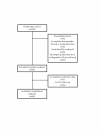How do people with knee osteoarthritis use osteoarthritis pain medications and does this change over time? Data from the Osteoarthritis Initiative
- PMID: 24008023
- PMCID: PMC3978852
- DOI: 10.1186/ar4286
How do people with knee osteoarthritis use osteoarthritis pain medications and does this change over time? Data from the Osteoarthritis Initiative
Abstract
Introduction: The aim of this analysis was to describe comprehensively the cross-sectional and longitudinal patterns of analgesic and nutraceutical medication use for knee osteoarthritis (OA) in a contemporary US cohort and to investigate associated demographic and clinical factors.
Methods: Baseline, 12, 24 and 36 month data were obtained retrospectively from the National Institutes of Health Osteoarthritis Initiative. Participants had symptomatic radiographic knee OA. Multiple binary logistic regression models identified characteristics independently associated with the use of analgesics or nutraceuticals.
Results: We included 987 subjects (55.9% female, mean age 61.5 years, 71.0% white). At baseline, 68.2% reported frequent use of a conventional analgesic or nutraceutical for joint pain (for more than half of the previous month). Non-prescription non-steroidal anti-inflammatory drugs (NSAIDs) were the most frequently reported medications (26.8%), even in those more than 75-years old. Multiple conventional analgesics were used by 11.9%. Frequent analgesic use was more likely in women (odds ratio (OR) 1.8 (95% confidence interval (CI) 1.3 to 2.3)) and people with more pain (moderate 1.7 (1.2 to 2.4); severe 3.1 (2.1 to 4.7)); nutraceutical use was less likely in non-whites (0.4 (0.3 to 0.6)), those more than 74-years old (0.6 (0.3 to 0.9)) and those with comorbidities (0.6 (0.5 to 0.9)) and more likely in people with Kellgren-Lawrence (KL) grade 4 (2.2 (1.5 to 3.3)). Overall there was no change in the proportion of participants frequently using prescription or over the counter (OTC) analgesics at 36 months, although most people had changed medication type; of those using a traditional analgesic at baseline approximately one third were still using the same type at 36 months (ranging from 26.2% of baseline prescription NSAID users to 40.6% of baseline acetaminophen users). All participants reporting baseline analgesic use also reported 36 month analgesic use. Female participants (OR 95% CI 1.2 to 3.2, P = 0.009), those with high body mass index (1.2 to 4.8, P = 0.010) and those with moderate (1.6 to 2.6, P = 0.090) or severe (1.8 to 12.0, P = 0.002) baseline pain were more likely to use pain medication during the 36 month follow-up period; participants more than 75-years old were less likely (0.2 to 1.0, P = 0.053).
Conclusions: Most people with knee OA used pharmacological therapies frequently, and use appeared to be according to American College of Rheumatology recommendations. Change in medication type used was common. Persistent non-prescription NSAID use in older people is an area of concern.
Figures
Similar articles
-
Medication and supplement use for managing joint symptoms among patients with knee and hip osteoarthritis: a cross-sectional study.BMC Musculoskelet Disord. 2012 Mar 29;13:47. doi: 10.1186/1471-2474-13-47. BMC Musculoskelet Disord. 2012. PMID: 22458305 Free PMC article.
-
Joint-pain comorbidity, health status, and medication use in hip and knee osteoarthritis: a cross-sectional study.Arthritis Care Res (Hoboken). 2012 Jan;64(1):54-8. doi: 10.1002/acr.20647. Arthritis Care Res (Hoboken). 2012. PMID: 21954220
-
Analgesic use in patients with knee and/or hip osteoarthritis referred to an outpatient center: a cross-sectional study within the Amsterdam Osteoarthritis Cohort.Rheumatol Int. 2017 Oct;37(10):1747-1755. doi: 10.1007/s00296-017-3785-3. Epub 2017 Aug 18. Rheumatol Int. 2017. PMID: 28821939
-
Tramadol for osteoarthritis.Cochrane Database Syst Rev. 2019 May 27;5(5):CD005522. doi: 10.1002/14651858.CD005522.pub3. Cochrane Database Syst Rev. 2019. PMID: 31132298 Free PMC article.
-
Oral non-steroidal anti-inflammatory drugs versus other oral analgesic agents for acute soft tissue injury.Cochrane Database Syst Rev. 2020 Aug 12;8(8):CD007789. doi: 10.1002/14651858.CD007789.pub3. Cochrane Database Syst Rev. 2020. PMID: 32797734 Free PMC article.
Cited by
-
The impact of moderate to severe osteoarthritis on the physical performance and quality of life: a cross-sectional study in Greek patients (PONOS study).BMC Musculoskelet Disord. 2023 Aug 15;24(1):651. doi: 10.1186/s12891-023-06770-7. BMC Musculoskelet Disord. 2023. PMID: 37582740 Free PMC article.
-
Safety of Paracetamol in Osteoarthritis: What Does the Literature Say?Drugs Aging. 2019 Apr;36(Suppl 1):7-14. doi: 10.1007/s40266-019-00658-9. Drugs Aging. 2019. PMID: 31073920 Free PMC article. Review.
-
Dosage effects of histamine-2 receptor antagonist on the primary prophylaxis of non-steroidal anti-inflammatory drug (NSAID)-associated peptic ulcers: a retrospective cohort study.Drug Saf. 2014 Sep;37(9):711-21. doi: 10.1007/s40264-014-0209-0. Drug Saf. 2014. PMID: 25096957
-
The Health Seeking Behaviors and Perceptions of Iranian Patient with Osteoarthritis about Pain Management: A Qualitative Study.J Caring Sci. 2017 Mar 1;6(1):81-93. doi: 10.15171/jcs.2017.009. eCollection 2017 Mar. J Caring Sci. 2017. PMID: 28299300 Free PMC article.
-
Opioid users show worse baseline knee osteoarthritis and faster progression of degenerative changes: a retrospective case-control study based on data from the Osteoarthritis Initiative (OAI).Arthritis Res Ther. 2021 May 22;23(1):146. doi: 10.1186/s13075-021-02524-9. Arthritis Res Ther. 2021. PMID: 34022942 Free PMC article.
References
-
- Keenan AM, McKenna SP, Doward LC, Conaghan PG, Emery P, Tennant A. Development and validation of a needs-based quality of life instrument for osteoarthritis. Arthritis Rheum. 2008;15:841–848. - PubMed
-
- Stewart WF, Ricci JA, Chee E, Morganstein D, Lipton R. Lost productive time and cost due to common pain conditions in the US workforce. JAMA. 2003;15:2443–2454. - PubMed
-
- Yelin E, Sonneborn D, Trupin L. The prevalence and impact of accommodations on the employment of persons 51-61 years of age with musculoskeletal conditions. Arthritis Care Res. 2000;15:168–176. - PubMed
-
- Arthritis Care; OANation. 2012. http://www.arthritiscare.org.uk/LivingwithArthritis/oanation-2012
-
- Murray CJ, Lopez AD. Alternative projections of mortality and disability by cause 1990-2020: Global Burden of Disease Study. Lancet. 1997;15:1498–1504. - PubMed
Publication types
MeSH terms
Substances
Grants and funding
LinkOut - more resources
Full Text Sources
Other Literature Sources


